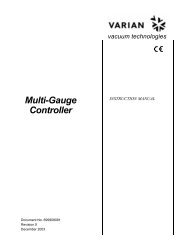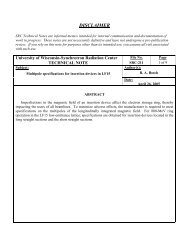SRC Users' Meeting - Synchrotron Radiation Center - University of ...
SRC Users' Meeting - Synchrotron Radiation Center - University of ...
SRC Users' Meeting - Synchrotron Radiation Center - University of ...
Create successful ePaper yourself
Turn your PDF publications into a flip-book with our unique Google optimized e-Paper software.
LOW-DIMENSIONAL ELECTRONS AT SILICON SURFACES<br />
J. N. Crain 1 , J. L. McChesney 1 , Fan Zheng 1 , M. C. Gallagher 2 , P. C. Snijders 3 , M. Bissen 4 ,<br />
C. Gundelach 4 , S. C. Erwin 5 , and F. J. Himpsel 1<br />
1 Dept. <strong>of</strong> Physics, UW-Madison, 1150 <strong>University</strong> Ave., Madison, Wisconsin 53706<br />
2 Dept. <strong>of</strong> Physics, Lakehead <strong>University</strong>, Thunder Bay, ON P7B-5E1 Canada<br />
3 Dept. <strong>of</strong> NanoScience, Delft <strong>University</strong> <strong>of</strong> Technology,<br />
Lorentzweg, 2628 CJ Delft, The Netherlands<br />
4 <strong>Synchrotron</strong> <strong>Radiation</strong> <strong>Center</strong>, UW-Madison, 3731 Schneider Dr., Stoughton, WI 53589<br />
5 <strong>Center</strong> for Computational Materials Science, Naval Research Laboratory,<br />
Washington, DC 20375<br />
Electrons become increasingly correlated as the dimensionality is reduced from 3D to<br />
2D and 1D. Already in 2D one observes correlations between electrons and vortices in the<br />
quantum Hall effect leading to fractional charge and statistics. Predictions for a 1D metal<br />
anticipate a complete breakdown <strong>of</strong> the single electron concept and the separation <strong>of</strong> spin and<br />
charge into two collective excitations, spinons and holons.<br />
It has become possible to systematically engineer two- and one-dimensional surface<br />
structures <strong>of</strong> metals on silicon that are metallic [1,2]. Electrons near the Fermi level are decoupled<br />
from the substrate because there energy lies in the band gap. The metal atoms,<br />
however, are rigidly tied to the silicon lattice in substitutional positions according to x-ray<br />
diffraction [3] and first principles band calculations. That makes a Peierls transition to an<br />
insulator unfavorable and creates an opportunity for observing exotic states predicted for onedimensional<br />
metallic electrons.<br />
Examples <strong>of</strong> two-dimensional metals are the 3x3 and 21x21 reconstructions <strong>of</strong><br />
Ag and Au on Si(111), which exhibit an intricate pattern <strong>of</strong> Fermi surfaces induced by the<br />
superlattice [2]. Information about the Fourier components <strong>of</strong> the superlattice potential is<br />
obtained from avoided band crossings.<br />
One-dimensional atomic chains are created by growing Au and a variety <strong>of</strong> other<br />
metals at vicinal Si(111) surfaces in the 1/5 monolayer coverage regime [1]. This appears to<br />
be a rather universal phenomenon, and even the flat Si(111) surface breaks its three-fold<br />
symmetry to accommodate chain structures. This wide-open territory <strong>of</strong> 1D structures is<br />
explored in real and reciprocal space by scanning tunneling microscopy (STM) and angleresolved<br />
photoemission. The resulting energy bands and Fermi surfaces can be tuned between<br />
2D and 1D by increasing the chain spacing, with the intra-chain / inter-chain coupling ratio<br />
varying from 10:1 to >70:1. Unexpected metallic bands are found, such as a pair <strong>of</strong> nearly<br />
degenerate, half-filled bands, a quarter-filled band, and a fractional electron count <strong>of</strong> 8/3<br />
electrons per 1x1 cell [1]. A possible explanation for the fractional electron count is<br />
suggested, where extra Si atoms in a 2D cell “dope” the 1D chain embedded in it. This would<br />
be analogous to the doping in HiT c materials, where a 3D cell dopes an embedded 2D plane.<br />
References:<br />
[1] Losio, et al., Phys. Rev. Lett. 86, 4632 (2001); Altmann et al. Phys. Rev. B 64, 035406<br />
(2001); Crain et al., Phys Rev. Lett., in press (2003).<br />
[2] Crain, et al., Phys. Rev. B 66, 205302 (2002).<br />
[3] Robinson, et al., Phys. Rev. Lett. 88, 096104 (2002).
















